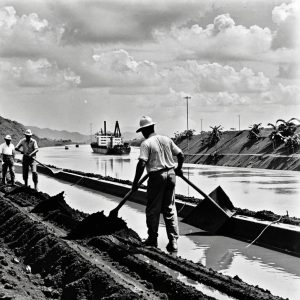The construction of the Panama Canal stands as one of the greatest engineering feats in human history, forever altering the way goods, people, and ideas move across the globe. Spanning the narrow isthmus of Panama, the canal connects the Atlantic and Pacific Oceans, reducing travel time for ships by thousands of miles. Before its completion in 1914, ships were forced to take the long and perilous journey around the southern tip of South America, the treacherous Cape Horn. The vision for a shortcut through the continent was dreamt up by several generations, but it wasn’t until the late 19th century that the project gained serious momentum under French engineer Ferdinand de Lesseps. His initial attempt to build the canal, however, was marred by technical failures and a devastating loss of life due to tropical diseases such as malaria and yellow fever.
In 1904, the United States took over the project, under the leadership of President Theodore Roosevelt, recognizing the canal’s immense strategic and economic importance. The American effort, led by John Stevens and later George Washington Goethals, overcame countless challenges, from the engineering complexity of digging through mountains to the management of widespread health crises. The U.S. invested heavily in controlling the spread of disease by implementing revolutionary public health measures, including the work of Dr. William Gorgas, whose efforts in eradicating mosquitoes helped make the canal project feasible. By 1914, the Panama Canal was completed, a monumental achievement that reshaped international trade routes and global politics.
The canal’s impact was immediate and profound. It not only facilitated a boom in international commerce, particularly for shipping industries, but also enhanced the U.S. military’s ability to project power across both oceans. Economically, it opened up new markets and drastically reduced the cost of transporting goods, particularly between the East and West coasts of the United States. The canal also had geopolitical ramifications, cementing the U.S. as a dominant force in the Western Hemisphere. In 1999, control of the canal was handed over to Panama, marking a new chapter in the region’s history, yet the canal’s influence on global trade and political relations remains as potent as ever.
Today, the Panama Canal is not just an engineering wonder; it is a symbol of human determination, innovation, and collaboration. It reminds us of the ability to overcome adversity and the far-reaching consequences of ambitious projects that challenge the status quo. As global trade continues to grow, the canal stands as a testament to how one man’s vision can ripple across the world and change the course of history forever.

